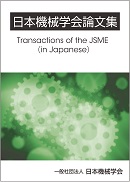85 巻, 869 号
選択された号の論文の16件中1~16を表示しています
- |<
- <
- 1
- >
- >|
材料力学,機械材料,材料加工
-
2019 年 85 巻 869 号 p. 18-00304
発行日: 2019年
公開日: 2019/01/25
[早期公開] 公開日: 2018/12/19PDF形式でダウンロード (2830K)
流体工学,流体機械
-
2019 年 85 巻 869 号 p. 18-00368
発行日: 2019年
公開日: 2019/01/25
[早期公開] 公開日: 2018/12/13PDF形式でダウンロード (3206K)
熱工学,内燃機関,動力エネルギーシステム
-
2019 年 85 巻 869 号 p. 18-00268
発行日: 2019年
公開日: 2019/01/25
[早期公開] 公開日: 2018/12/20PDF形式でダウンロード (1397K) -
2019 年 85 巻 869 号 p. 18-00312
発行日: 2019年
公開日: 2019/01/25
[早期公開] 公開日: 2018/12/26PDF形式でダウンロード (2313K) -
2019 年 85 巻 869 号 p. 18-00345
発行日: 2019年
公開日: 2019/01/25
[早期公開] 公開日: 2018/12/26PDF形式でダウンロード (2817K)
機械力学,計測,自動制御,ロボティクス,メカトロニクス
-
2019 年 85 巻 869 号 p. 18-00195
発行日: 2019年
公開日: 2019/01/25
[早期公開] 公開日: 2018/12/17PDF形式でダウンロード (1719K) -
2019 年 85 巻 869 号 p. 18-00228
発行日: 2019年
公開日: 2019/01/25
[早期公開] 公開日: 2018/12/17PDF形式でダウンロード (1749K) -
2019 年 85 巻 869 号 p. 18-00252
発行日: 2019年
公開日: 2019/01/25
[早期公開] 公開日: 2018/12/19PDF形式でダウンロード (25378K) -
2019 年 85 巻 869 号 p. 18-00299
発行日: 2019年
公開日: 2019/01/25
[早期公開] 公開日: 2018/12/19PDF形式でダウンロード (2498K) -
2019 年 85 巻 869 号 p. 18-00320
発行日: 2019年
公開日: 2019/01/25
[早期公開] 公開日: 2018/12/19PDF形式でダウンロード (1519K) -
2019 年 85 巻 869 号 p. 18-00344
発行日: 2019年
公開日: 2019/01/25
[早期公開] 公開日: 2018/12/20PDF形式でダウンロード (1563K)
計算力学
-
2019 年 85 巻 869 号 p. 18-00371
発行日: 2019年
公開日: 2019/01/25
[早期公開] 公開日: 2018/12/17PDF形式でダウンロード (2558K)
設計,機素・潤滑,情報・知能,製造,システム
-
2019 年 85 巻 869 号 p. 18-00284
発行日: 2019年
公開日: 2019/01/25
[早期公開] 公開日: 2018/12/26PDF形式でダウンロード (2213K) -
2019 年 85 巻 869 号 p. 18-00381
発行日: 2019年
公開日: 2019/01/25
[早期公開] 公開日: 2018/12/26PDF形式でダウンロード (1565K)
環境工学,化学機械,システム安全
-
2019 年 85 巻 869 号 p. 18-00316
発行日: 2019年
公開日: 2019/01/25
[早期公開] 公開日: 2018/12/10PDF形式でダウンロード (3020K)
交通・物流
-
2019 年 85 巻 869 号 p. 18-00270
発行日: 2019年
公開日: 2019/01/25
[早期公開] 公開日: 2019/01/09PDF形式でダウンロード (1711K)
- |<
- <
- 1
- >
- >|
